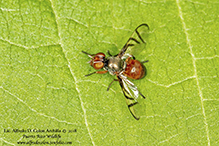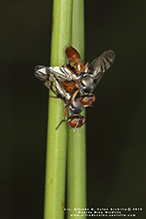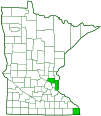signal fly
(Rivellia colei)
Conservation • Description • Habitat • Biology • Distribution • Taxonomy
Conservation Status |
|
|||||||
| IUCN Red List | not listed |
|||||||
| NatureServe | not listed |
|||||||
| Minnesota | not listed |
|||||||
Description |
||
Rivellia colei is a very small signal fly. It was first described in 1956. It occurs the eastern United States as far west as Minnesota, Nebraska, and Louisiana. Adults are ⅛″ to 3 ⁄16″ (4.0 to 4.9 mm) long. There are two large compound eyes at the side of the head and three small simple eyes (ocelli) in a triangle at the top of the head. The compound eyes are brownish-yellow. They do not meet at the top of the head in either sex. The face is concave when viewed from the side. The upper face, corresponding to the forehead (frons) is mostly brownish-yellow, black around the ocelli. There is a thin, white, powdery (pruinose) strip bordering each compound eye on the frons. The back of the head is convex when viewed from the side. The antennae have three segments. The first two segments are yellow. The second segment does not have a longitudinal groove (suture). The third segment is long and mostly yellow but black at the tip and on the sides. It has a short, feather-like (plumose), forward-pointing bristle (arista) on the upper side. The fine branches or filaments of the arista are very short. The thorax is large and has three segments. Each segment has four principal exoskeletal plates, one above, one below, and one on each side. The upper (dorsal) plates, from front to rear, are the prescutum, scutum, and scutellum. The prescutum and scutum are blackish-green and appear frosty (pruinose), mostly at the corners and especially at the sides. It is also covered with scattered pale hairs (setae). The scutellum is colored the same as the scutum and is pruinose except at the tip. It has two long and two short black, bristle-like setae at the rear margin, and a few short black setae submarginally. The abdomen is brownish-yellow, shiny, and rough (rugose). The first segment is covered with pale setae. On males, the setae on the underside of fourth abdominal plate are directed to the rear (posteriorly). The first and third segments of all legs (coxae and femora, respectively) are brownish-yellow. On the front and middle legs the fourth segment (tibia) is brownish-yellow. On the rear legs the tibia is black or brownish-yellow to dark brown. The last part of the leg, corresponding to the foot (tarsus) has five segments. On the front and back legs, the first segment is brownish-yellow, the remainder are slightly blackened. On the middle legs, the tarsi are entirely brownish-yellow. The wings are clear with four narrow black bands. The first vein extends along the front (costal) wing margin then bends inward, ending half way between the inner and outer margins. The second band begins at the costal margin, slightly separated from the first band, follows the margin for a short distance, then bends inward, ending two-thirds the way between the inner and outer margins. The third vein extends straight from the costal margin almost but not quite to the inner margin. The fourth band begins at the costal margin, the base joining the third band, and wraps around the tip of the wing at the margin. The anal wing cell is rounded at the tip, with no pointed extension. The vein at the forward margin (costal vein) is complete, not broken. The first branch of the radial sector vein (R2+3) is long, ending beyond the middle of the wing. |
||
Size |
||
Total length: ⅛″ to 3 ⁄16″ |
||
Similar Species |
||
Soybean nodule fly (Rivellia quadrifasciata) females are identical morphologically. Males have setae on the underside of fourth abdominal plate directed radially. Though more common and widespread, there is only one recorded sighting of it in Minnesota. Female Rivellia colei cannot be distinguished from Rivellia quadrifasciata. The only difference in the male that is discernible in a live specimen is the direction of the setae on the fourth abdominal segment. On R. colei they are pointed toward the rear. On R. quadrifasciata they are direct radially. In the lab, dissection of the male genitalia is the most reliable way to distinguish between the two species. R. quadrifasciata is more common and widespread, but it has never been recorded in Minnesota, R. colei has been collected here. |
||
Habitat |
||
|
||
Biology |
||
Season |
||
|
||
Behavior |
||
|
||
Life Cycle |
||
|
||
Larva Food |
||
|
||
Adult Food |
||
|
||
Distribution |
||||
|
Sources A revision of the flies of the genus Rivellia (Otiidae, Diptera) of America north of Mexico Ryoji Namba. 1956. United States National Museum. |
|||
| 1/25/2021 | ||||
Occurrence |
||||
|
||||
Taxonomy |
|||
Order |
Diptera (flies) | ||
Suborder |
Brachycera | ||
Infraorder |
Muscomorpha | ||
| No Rank | Eremoneura | ||
| No Rank | Cyclorrhapha | ||
| Zoosection | Schizophora (schizophora flies) | ||
| Zoosubsection | Acalyptratae (acalyptrate flies) | ||
Superfamily |
Tephritoidea (fruit, signal, and picture-winged flies) | ||
Family |
Platystomatidae (signal flies) | ||
Subfamily |
Platystomatinae | ||
Genus |
Rivellia | ||
Synonyms |
|||
|
|||
Common Names |
|||
This species has no common name. The common name of the family Platystomatidae is signal flies, and it is applied here for convenience. |
|||
Glossary
Arista
A large bristle on the upper side of the third segment of the antenna of a fly.
Femur
On insects and arachnids, the third, largest, most robust segment of the leg, coming immediately before the tibia. On humans, the thigh bone.
Ocellus
Simple eye; an eye with a single lens. Plural: ocelli.
Scutellum
The exoskeletal plate covering the rearward (posterior) part of the middle segment of the thorax in some insects. In Coleoptera, Hemiptera, and Homoptera, the dorsal, often triangular plate behind the pronotum and between the bases of the front wings. In Diptera, the exoskeletal plate between the abdomen and the thorax.
Scutum
The forward (anterior) portion of the middle segment of the thorax (mesonotum) in insects and some arachnids.
Seta
A stiff, hair-like process on the outer surface of an organism. In Lepidoptera: A usually rigid bristle- or hair-like outgrowth used to sense touch. In mosses: The stalk supporting a spore-bearing capsule and supplying it with nutrients. Plural: setae. Adjective: setose.
Tarsus
On insects, the last two to five subdivisions of the leg, attached to the tibia; the foot. On spiders, the last segment of the leg. Plural: tarsi.
Tibia
The fourth segment of an insect leg, after the femur and before the tarsus (foot).
Visitor Photos |
|||||
Share your photo of this insect. |
|||||
| This button not working for you? Simply email us at info@MinnesotaSeasons.com. Attach one or more photos and, if you like, a caption. |
|||||
Alfredo Colon |
|||||
 |
 |
||||
MinnesotaSeasons.com Photos |
|||||
|
|||||

Slideshows |
||

Visitor Videos |
|||
Share your video of this insect. |
|||
| This button not working for you? Simply email us at info@MinnesotaSeasons.com. Attach a video, a YouTube link, or a cloud storage link. |
|||
Other Videos |
|||


Created: 2/3/2019
Last Updated:


